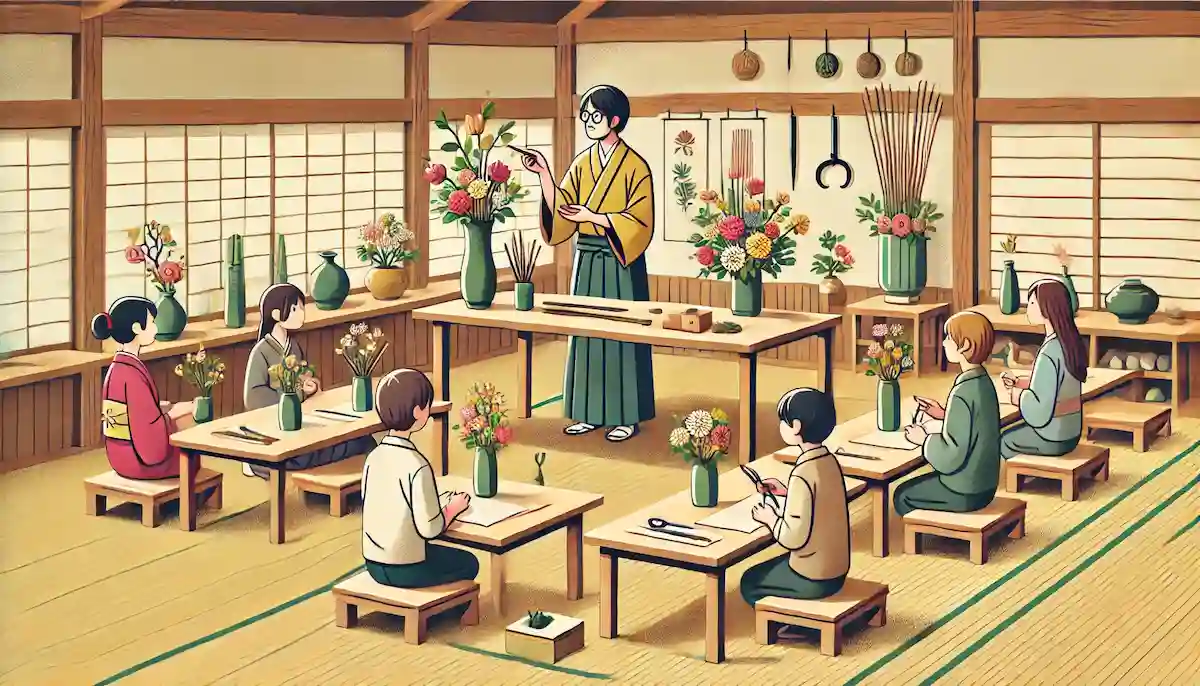華道を英語で説明・紹介するための基本情報と、英会話に役立つ表現をシンプルでわかりやすい英語で紹介します。
英会話ダイアローグ・関連情報・10の質問を通して、華道に関する英語表現を学びます。
英語
英会話ダイアローグを読む前に知っておくと良い前提知識と情報は以下の通りです。
- 華道(生け花)の歴史
- 起源: 6世紀頃の仏教伝来とともに、仏前に花を供える習慣から始まった
- 発展: 鎌倉時代から室町時代にかけて技法が発展し、様々な流派が生まれた
- 主要な流派
- 池坊流: 最も古く、形式的な構造を重視
- 草月流: 創造性と現代的な表現を奨励
- 小原流: 自然の美しさと季節の変化を重視
- 基本的な技法
- 三角形の構図: 天、地、人を表す
- 間: 花と花の空間を大切にし、全体の調和を図る
- 自然な形: 花材の自然な形や曲線を尊重する
- 西洋のフラワーアレンジメントとの違い
- 華道: シンプルさ、自然との調和、内面的な平安を重視、少ない花材で空間を強調
- 西洋のフラワーアレンジメント: 豊富な花材を使用し、色彩や形の対比を強調
- 華道体験の魅力
- リラックス効果: 生花の過程はリラックスできる
- 創造性の発揮: 美しいアレンジメントを作る楽しさ
- 文化的な学び: 日本文化や美意識を理解できる
2人が華道(生け花)について話しています。
華道の歴史、主要な流派、基本的な技法、西洋のフラワーアレンジメントとの違い、華道体験の魅力などを話題にしています。
会話 / dialogue

Hi Key, I heard you’re interested in kado. What got you into it?

Hi Mack! Yes, I’ve recently become fascinated by it. The elegance and simplicity really appeal to me. Can you tell me more about its history?

Sure! Kado, or Japanese flower arranging, started in the 6th century with Buddhism. It evolved over centuries, especially during the Kamakura and Muromachi periods. The Ikenobo school, founded in the 15th century, is the oldest.

That’s interesting. Are there different schools of kado?

Yes, there are several major schools. The Ikenobo school is very traditional, focusing on formal structures. The Sogetsu school encourages creativity and modern expressions, and the Ohara school emphasizes natural beauty and seasonal changes.

I see. What are some basic techniques used in kado?

One key technique is the triangular composition, representing heaven, earth, and human. Another important concept is “ma,” which means space. Kado uses fewer flowers to highlight the space around them and respects their natural shapes.

How does it differ from Western flower arranging?

Kado focuses on simplicity, harmony with nature, and inner peace. It uses fewer flowers and emphasizes space. In contrast, Western arrangements use more flowers, emphasize color contrasts, and are often used for decoration and celebrations.

I’d love to try it. Are there any classes for beginners?

Definitely! Many places offer short kado classes for tourists. These sessions usually last one to two hours, making them perfect for getting a taste of the art.

That sounds perfect. Why do you think kado is popular with foreigners?

It’s a unique cultural experience that’s both relaxing and creative. Plus, the beautiful arrangements are great for photos, which people love to share on social media.

I can see why it’s appealing. Do you have any tips for starting out?

Start with the basics, like understanding the three main elements: heaven, earth, and human. Also, pay attention to the natural shape of your flowers and the space around them. It’s all about finding harmony and balance.

Thanks, Mack. I’m excited to give it a try. Maybe we can take a class together sometime?

I’d love that! It’s a great way to relax and learn something new about Japanese culture. Let’s find a class soon.

Sounds like a plan. Thanks for all the information!

Anytime, Key. Enjoy your kado journey!
関連情報 / related information
「華道」について、理解を深めるための「英語での関連情報」です。
華道

What is Kado?
Kado, also known as Japanese flower arranging, is a traditional art form in Japan. It started in the 6th century with the introduction of Buddhism. People began offering flowers in front of Buddha statues. Over time, kado developed into an art that expresses beauty through simple and elegant flower arrangements.
Main Schools
There are several main schools of kado. The Ikenobo school is the oldest, focusing on formal and structured arrangements. The Sogetsu school encourages creativity and modern styles, allowing for more personal expression. The Ohara school emphasizes natural beauty and the changing seasons, creating arrangements that reflect the natural world.
Basic Techniques
Kado uses a few basic techniques. One important technique is the triangular composition, which represents heaven, earth, and human. Another key concept is “ma,” or space, which is the empty space around the flowers. This space is as important as the flowers themselves. Kado also respects the natural shape and line of each flower, creating harmony and balance.
Differences from Western Flower Arranging
Kado is different from Western flower arranging. Kado focuses on simplicity, harmony with nature, and inner peace. It uses fewer flowers and emphasizes the space around them. Western flower arranging often uses many flowers and focuses on color and shape contrasts. It is usually used for decoration and celebrations.
Why Try Kado?
Kado is a relaxing and creative activity. It helps you understand Japanese culture and aesthetics. Many places offer short classes for beginners, making it easy to try. You can enjoy making beautiful arrangements and feel a sense of peace and achievement.
10の質問 / 10 questions
「華道」について、理解を深めるための「英語での10の質問」です。
1: What is kado?
Kado, also known as Japanese flower arranging, is a traditional art form that focuses on creating beautiful flower arrangements with a deep respect for nature.
2: When did kado start?
Kado began in the 6th century with the introduction of Buddhism to Japan. People started offering flowers in front of Buddha statues.
3: What are the main schools of kado?
The main schools of kado are Ikenobo, Sogetsu, and Ohara. Each school has its own unique style and philosophy.
4: What does the Ikenobo school focus on?
The Ikenobo school is the oldest and focuses on formal and structured arrangements, emphasizing balance and harmony.
5: How does the Sogetsu school differ from Ikenobo?
The Sogetsu school encourages creativity and modern styles, allowing for more personal expression compared to the traditional Ikenobo school.
6: What is the concept of "ma" in kado?
"Ma" refers to the space around and between the flowers. In kado, this empty space is as important as the flowers themselves.
7: How does kado differ from Western flower arranging?
Kado focuses on simplicity, harmony with nature, and inner peace, using fewer flowers and emphasizing space. Western flower arranging often uses many flowers and focuses on color and shape contrasts.
8: Why is kado popular among foreigners?
Kado is popular among foreigners because it offers a unique cultural experience, is relaxing and creative, and the beautiful arrangements are great for photos.
9: Can beginners try kado?
Yes, many places offer short kado classes for beginners. These classes usually last one to two hours, making it easy to try the art.
10: What do you need to start practicing kado?
To start practicing kado, you need basic tools like scissors, a kenzan (spiked holder), a suitable vase, and flowers. You also need to learn the basic techniques and principles of kado.
和訳付
会話 / dialogue

Hi Key, I heard you’re interested in kado. What got you into it?
こんにちは、キー。華道に興味があるって聞いたけど、きっかけは何だったの?

Hi Mack! Yes, I’ve recently become fascinated by it. The elegance and simplicity really appeal to me. Can you tell me more about its history?
こんにちは、マック! そうなんだ、最近すごく魅了されているの。優雅さとシンプルさがすごく好きで。華道の歴史についてもっと教えてくれない?

Sure! Kado, or Japanese flower arranging, started in the 6th century with Buddhism. It evolved over centuries, especially during the Kamakura and Muromachi periods. The Ikenobo school, founded in the 15th century, is the oldest.
もちろん! 華道は6世紀に仏教と共に始まったんだ。特に鎌倉時代と室町時代に発展したんだよ。15世紀に創設された池坊が最も古い流派なんだ。

That’s interesting. Are there different schools of kado?
それは興味深いね。華道にはいくつかの流派があるの?

Yes, there are several major schools. The Ikenobo school is very traditional, focusing on formal structures. The Sogetsu school encourages creativity and modern expressions, and the Ohara school emphasizes natural beauty and seasonal changes.
うん、いくつかの主要な流派があるんだ。池坊は非常に伝統的で、形式的な構造に重点を置いているよ。草月流は創造性と現代的な表現を奨励していて、小原流は自然の美しさと季節の変化を強調しているんだ。

I see. What are some basic techniques used in kado?
なるほど。華道で使われる基本的な技法にはどんなものがあるの?

One key technique is the triangular composition, representing heaven, earth, and human. Another important concept is “ma,” which means space. Kado uses fewer flowers to highlight the space around them and respects their natural shapes.
重要な技法の一つは三角形の構図で、これは天、地、人を表しているんだ。もう一つの重要な概念は「間」で、これは空間を意味するんだ。華道では少ない花材を使って周りの空間を際立たせ、花の自然な形を尊重しているよ。

How does it differ from Western flower arranging?
それは西洋のフラワーアレンジメントとはどう違うの?

Kado focuses on simplicity, harmony with nature, and inner peace. It uses fewer flowers and emphasizes space. In contrast, Western arrangements use more flowers, emphasize color contrasts, and are often used for decoration and celebrations.
華道はシンプルさ、自然との調和、内面的な平安に重点を置いているんだ。少ない花材を使って空間を強調するんだ。それに対して、西洋のアレンジメントは花の量が多く、色の対比を強調し、装飾や祝祭のために使われることが多いんだ。

I’d love to try it. Are there any classes for beginners?
ぜひ試してみたいな。初心者向けのクラスはあるの?

Definitely! Many places offer short kado classes for tourists. These sessions usually last one to two hours, making them perfect for getting a taste of the art.
もちろん! 多くの場所で観光客向けの短時間の華道クラスを提供しているよ。これらのセッションは通常1〜2時間だから、華道を試してみるには最適だよ。

That sounds perfect. Why do you think kado is popular with foreigners?
それはいいね。どうして華道が外国人に人気だと思う?

It’s a unique cultural experience that’s both relaxing and creative. Plus, the beautiful arrangements are great for photos, which people love to share on social media.
独特の文化体験で、リラックスしながら創造性を発揮できるからね。それに、美しいアレンジメントは写真映えするから、みんなSNSでシェアするのが好きなんだ。

I can see why it’s appealing. Do you have any tips for starting out?
魅力的なのがよく分かるよ。始めるためのアドバイスはある?

Start with the basics, like understanding the three main elements: heaven, earth, and human. Also, pay attention to the natural shape of your flowers and the space around them. It’s all about finding harmony and balance.
基本から始めるといいよ。天、地、人の三つの主要な要素を理解することからね。あと、花の自然な形や周りの空間に注意を払うことが大切だよ。調和とバランスを見つけることがすべてなんだ。

Thanks, Mack. I’m excited to give it a try. Maybe we can take a class together sometime?
ありがとう、マック。試してみるのが楽しみだな。いつか一緒にクラスを受けてみない?

I’d love that! It’s a great way to relax and learn something new about Japanese culture. Let’s find a class soon.
ぜひそうしよう! リラックスしながら日本文化について新しいことを学べるいい機会だよ。すぐにクラスを見つけよう。

Sounds like a plan. Thanks for all the information!
いいね。いろいろ教えてくれてありがとう!

Anytime, Key. Enjoy your kado journey!
いつでもどういたしまして。華道の旅を楽しんでね!
関連情報 / related information
華道

What is Kado?
Kado, also known as Japanese flower arranging, is a traditional art form in Japan. It started in the 6th century with the introduction of Buddhism. People began offering flowers in front of Buddha statues. Over time, kado developed into an art that expresses beauty through simple and elegant flower arrangements.
華道、または日本の生け花は、日本の伝統的な芸術形式です。6世紀に仏教の導入とともに始まりました。人々は仏像の前に花を供えるようになりました。時が経つにつれて、華道はシンプルで優雅な花のアレンジメントを通じて美を表現する芸術に発展しました。
Main Schools
There are several main schools of kado. The Ikenobo school is the oldest, focusing on formal and structured arrangements. The Sogetsu school encourages creativity and modern styles, allowing for more personal expression. The Ohara school emphasizes natural beauty and the changing seasons, creating arrangements that reflect the natural world.
華道にはいくつかの主要な流派があります。池坊流は最も古く、形式的で構造化されたアレンジメントに焦点を当てています。草月流は創造性と現代的なスタイルを奨励し、より個人的な表現を可能にします。小原流は自然の美しさと季節の変化を強調し、自然界を反映したアレンジメントを作り出します。
Basic Techniques
Kado uses a few basic techniques. One important technique is the triangular composition, which represents heaven, earth, and human. Another key concept is “ma,” or space, which is the empty space around the flowers. This space is as important as the flowers themselves. Kado also respects the natural shape and line of each flower, creating harmony and balance.
華道にはいくつかの基本技法があります。重要な技法の一つは三角形の構図で、これは天、地、人を表します。もう一つの重要な概念は「間」、つまり花の周りの空間です。この空間は花と同じくらい重要です。華道はまた、各花の自然な形やラインを尊重し、調和とバランスを作り出します。
Differences from Western Flower Arranging
Kado is different from Western flower arranging. Kado focuses on simplicity, harmony with nature, and inner peace. It uses fewer flowers and emphasizes the space around them. Western flower arranging often uses many flowers and focuses on color and shape contrasts. It is usually used for decoration and celebrations.
華道は西洋のフラワーアレンジメントとは異なります。華道はシンプルさ、自然との調和、内面的な平安に重点を置きます。少ない花材を使い、周りの空間を強調します。西洋のフラワーアレンジメントは多くの花を使い、色や形の対比に焦点を当てます。通常、装飾や祝祭のために使用されます。
Why Try Kado?
Kado is a relaxing and creative activity. It helps you understand Japanese culture and aesthetics. Many places offer short classes for beginners, making it easy to try. You can enjoy making beautiful arrangements and feel a sense of peace and achievement.
華道はリラックスできる創造的な活動です。日本の文化や美意識を理解するのに役立ちます。多くの場所で初心者向けの短時間のクラスが提供されており、簡単に試すことができます。美しいアレンジメントを作る楽しさを味わい、平和と達成感を感じることができます。
10の質問 / 10 questions
1: What is kado?
華道とは何ですか?
Kado, also known as Japanese flower arranging, is a traditional art form that focuses on creating beautiful flower arrangements with a deep respect for nature.
華道は日本の生け花とも呼ばれ、美しい花のアレンジメントを自然への深い敬意を持って作り出す伝統的な芸術形式です。
2: When did kado start?
華道はいつ始まりましたか?
Kado began in the 6th century with the introduction of Buddhism to Japan. People started offering flowers in front of Buddha statues.
華道は6世紀に仏教が日本に伝来した際に始まりました。人々は仏像の前に花を供え始めました。
3: What are the main schools of kado?
華道の主要な流派は何ですか?
The main schools of kado are Ikenobo, Sogetsu, and Ohara. Each school has its own unique style and philosophy.
華道の主要な流派には池坊流、草月流、小原流があります。各流派はそれぞれ独自のスタイルと哲学を持っています。
4: What does the Ikenobo school focus on?
池坊流は何に重点を置いていますか?
The Ikenobo school is the oldest and focuses on formal and structured arrangements, emphasizing balance and harmony.
池坊流は最も古く、形式的で構造化されたアレンジメントに重点を置き、バランスと調和を強調しています。
5: How does the Sogetsu school differ from Ikenobo?
草月流は池坊流とどう違いますか?
The Sogetsu school encourages creativity and modern styles, allowing for more personal expression compared to the traditional Ikenobo school.
草月流は創造性と現代的なスタイルを奨励し、伝統的な池坊流に比べてより個人的な表現を可能にします。
6: What is the concept of "ma" in kado?
華道における「間」の概念は何ですか?
"Ma" refers to the space around and between the flowers. In kado, this empty space is as important as the flowers themselves.
「間」とは花の周りや間の空間を指します。華道では、この空間は花そのものと同じくらい重要です。
7: How does kado differ from Western flower arranging?
華道は西洋のフラワーアレンジメントとどう違いますか?
Kado focuses on simplicity, harmony with nature, and inner peace, using fewer flowers and emphasizing space. Western flower arranging often uses many flowers and focuses on color and shape contrasts.
華道はシンプルさ、自然との調和、内面的な平安に重点を置き、少ない花材を使い空間を強調します。西洋のフラワーアレンジメントは多くの花を使い、色や形の対比に焦点を当てます。
8: Why is kado popular among foreigners?
なぜ華道は外国人に人気があるのですか?
Kado is popular among foreigners because it offers a unique cultural experience, is relaxing and creative, and the beautiful arrangements are great for photos.
華道は独特の文化体験を提供し、リラックスできて創造的であり、美しいアレンジメントが写真映えするため、外国人に人気があります。
9: Can beginners try kado?
初心者でも華道を試せますか?
Yes, many places offer short kado classes for beginners. These classes usually last one to two hours, making it easy to try the art.
はい、多くの場所で初心者向けの短時間の華道クラスが提供されています。これらのクラスは通常1〜2時間なので、簡単に試すことができます。
10: What do you need to start practicing kado?
華道を始めるには何が必要ですか?
To start practicing kado, you need basic tools like scissors, a kenzan (spiked holder), a suitable vase, and flowers. You also need to learn the basic techniques and principles of kado.
華道を始めるには、ハサミ、剣山、適切な花器、花などの基本的な道具が必要です。また、華道の基本的な技法と原則を学ぶ必要があります。
words & phrases
英会話ダイアローグと関連情報に出てきた単語・フレーズです(例文は各3つ)。

school : 名詞
意味: 学校、教育機関。または、特定の分野や芸術における流派。An institution for educating children or a particular style or group in art or thought.
(華道の主要な流派を指す)
例文:
- The Ikenobo school is the oldest school of kado.
「池坊流は華道の最も古い流派です。」 - The Sogetsu school of kado encourages creativity and modern expressions.
「草月流の華道は創造性と現代的な表現を奨励しています。」 - The Ohara school focuses on natural beauty and the changing seasons.
「小原流は自然の美しさと季節の変化に焦点を当てています。」
triangular : 形容詞
意味: 三角形の、三者間の。Shaped like a triangle; involving three people or things.
(華道で使われる三角形の構図を指す)
例文:
- The artist created a triangular sculpture.
「その芸術家は三角形の彫刻を作りました。」 - In kado, the arrangement often uses a triangular composition.
「華道では、アレンジメントによく三角形の構図が使われます。」 - They sat in a triangular formation.
「彼らは三角形の配置で座りました。」
composition : 名詞
意味: 構成、作曲、作文。The way in which something is put together or arranged; a piece of music or writing.
(華道における花の配置を指す)
例文:
- The composition of the team is diverse.
「チームの構成は多様です。」 - The artist’s new composition was praised by critics.
「その芸術家の新しい作品は批評家たちに称賛されました。」 - Kado uses a triangular composition for balance.
「華道ではバランスを取るために三角形の構図を使用します。」
aesthetics : 名詞
意味: 美学、美的感覚。The study of beauty and taste, particularly in art.
(華道の美的感覚や美意識を指す)
例文:
- He studied aesthetics at university.
「彼は大学で美学を学びました。」 - Kado emphasizes simplicity and natural aesthetics.
「華道はシンプルさと自然の美学を重視します。」 - The aesthetics of the building are modern and sleek.
「その建物の美的感覚は現代的で洗練されています。」
represent : 動詞
意味: 表す、代表する。To symbolize, stand for, or depict something; to act on behalf of someone or something.
(華道で天、地、人を表すことを指す)
例文:
She will represent her company at the conference.
「彼女は会議で会社を代表します。」
The flag represents the country’s heritage.
「その旗は国の遺産を表しています。」
In kado, the arrangement often represents heaven, earth, and human.
「華道では、アレンジメントはしばしば天、地、人を表します。」
